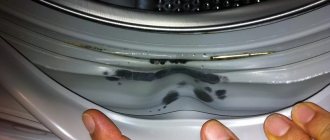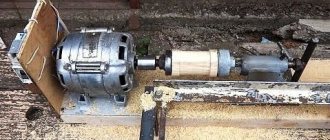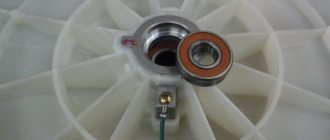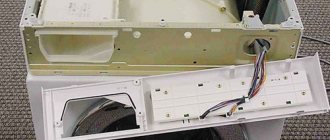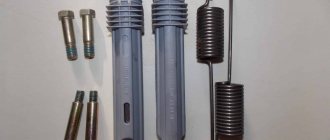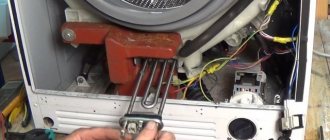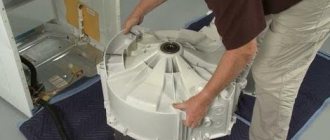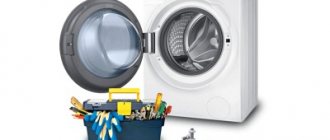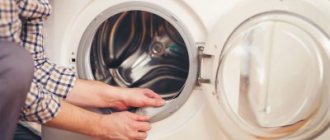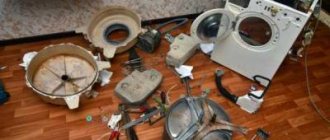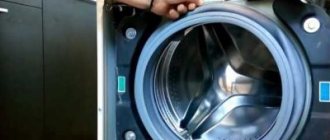When a washing machine leaks, a “local apocalypse” occurs. The housewife habitually loads things, selects the desired program and starts the wash, but after some time she notices a puddle formed on the floor, or drops flowing out from under the powder receptacle. This situation requires urgent action. First of all, you need to diagnose what exactly went wrong.
The manual is relevant for: Ardo / Ardo, Beko / Beko / Veko, Bosch Avantixx, Classixx, Logixx, Maxx, SportLine / Bosch Avantix, Classic / Classic, Logix, Max, Sportline; Brandt / Brandt, Candy Aquamatic, Holiday, CNE, CTS / Candy Aquamatic, Holiday; Daewoo / Daewoo, DEXP / Dexp, Electrolux Time Manager / Electrolux, excuse me, Timemanager, Evgo / Evgo, Gorenje / Gorenje, Haier / Hayer, Hansa / Hansa, Hotpoint Ariston Margherita, RSM, ARSL, ARWM / Hotpoint Ariston Margherita, Indesit IWSB , WISL, WISN, WITL, Innex / Indesit Wisl, Inex; LG / LJ/LV; Miele / Miele, Samsung Diamond, WF, EcoBubble, Bio Compact / Samsung Diamond, Eco Bubble, Bio Compact; Siemens / Siemens, Vestel / Vestel, Whirlpool AWG / Whirlpool, Zanussi Aquacycle, EcoValve / Zanussi Aquacycle, EcoValve; Atlant, Vyatka, Desna, Donbass, Malyutka-2, Saturn, Siberia, Fairy-2, Eureka-3 and other brands with vertical and horizontal loading, automatic and semi-automatic.
What to do if you notice a leak in your washing machine?
First of all, you need to take a number of measures to protect yourself and your home.
- Without stepping on the puddle, turn off the power to the washing machine: if possible, reach out and unplug the unit from the outlet. If you cannot do this, turn off the electricity at the distribution panel.
- Turn off the water: ideally, close the water supply tap to the washing machine. If this is not possible, we turn off all the water supply in the house in the plumbing closet.
- Now we take out the laundry from the washing machine. If the wash cycle is over, then do it as usual. If you notice a leak earlier and the washing stops halfway, then first drain the remaining water in the machine through the drain filter (it is located in the hatch in the lower right part of the front panel), and then remove the laundry.
Now you can begin to determine the location of the leak.
What to check first if your washing machine is leaking?
First of all, let’s check everything around: perhaps the problem is not in the machine, but a leaky water supply, sewerage or heating system pipe, and water just flowed under the washing machine? If everything is in order with the “surroundings,” we proceed to inspect the communications that lead to the washing machine.
Very often, water leaks in the washing machine are associated with problems with hoses : the inlet or drain hose could “move away” - children, pets, or simply too active cleaning could “help”. If you find that water is flowing from the connection points, try unscrewing the hose and screwing it back on, tightening the fixing nut. Also inspect the hoses along their entire length: it happens that the drain hose gets chafed if the washing machine is installed incorrectly. If you find a leak in the hose itself, it will need to be replaced. You can do this yourself, but please do not use hoses from the nearest market: it is better to take a slightly more expensive original hose from the washing machine manufacturer. It will last much longer than its “handicraft” brother!
If no signs of leakage are noticed in the area of communications, then the problem lies somewhere inside the unit itself.
The main types of breakdowns in which the washing machine leaks
A wide variety of problems can lead to water leaks. Some things can be diagnosed and even “cured” on your own. But in most cases, especially if water is pouring from somewhere “from within,” you cannot do without the help of a specialist.
| Symptoms of a problem | Possible problem |
| Water under the machine, leaking near the drain filter | Most likely, the drain filter in the washing machine is not screwed on properly. This happens if you drained water through it and did not “tighten it up”. It is necessary to unscrew the filter and carefully and tightly screw it to the end. Be careful or you may strip the thread! |
| Water flows from the dispenser (ditch) along the front panel of the washing machine | in the detergent dispenser hopper . It is necessary to rinse the dispenser properly: very often, powder sticks there, which over time, if the dispenser is not cleaned in time, can lead to clogging. |
| The water pressure in the water supply is too (most often in private homes). It is necessary to reduce the pressure by adjusting the position of the valve on the water supply hose. | |
| Water flows from the front – “from the hatch” and/or there is a puddle under the washer | Most likely, the rubber cuff of the hatch has leaked. If the puncture is on the front of the cuff, it flows through the hatch, if on the inside, water comes from under the washer. Most often, the cuffs suffer due to improper use of the machine: perhaps the seal was pinched by the hatch, or it became leaky due to the fact that small foreign objects got into it during washing. The sunroof seal needs to be repaired or replaced. If the puncture is slightly damaged, you can seal it with a rubber patch, detach the cuff and turn it so that the “patch” is in the upper part of the hatch: then when washing, water will not get to the “weak” place. If the cuff is pretty frayed, it is better to completely replace it. |
| The washing machine is leaking from below, there are no additional signs. | If all the functions of the washing machine are normal, but a puddle appears, most likely the problem is in the pipes . This could be a pipe from the inlet valve to the dispenser, from the dispenser to the tank, or a drain pipe. Damage to the pipes themselves or loose clamps can lead to leaks. For a full diagnosis, it is necessary to disassemble the washing machine and identify the problem area. It is enough to tighten the “loose” clamps, but if the pipes are damaged, they need to be replaced. |
How to drain the water
The remaining water is drained through the door, drain pipe, emergency or standard hose. Before starting the task, you need to disconnect the machine from the power supply, study the instructions for the device, prepare a bucket and dry floor rags.
Direct drainage through a door or hatch for storing laundry is only suitable for some models of equipment. Most horizontal machines block the opening of the hatch if there is water in the tank.
How to drain the water from the drum:
- Check the set mode. When the “No drain” function is active, start a forced spin and turn on the machine.
- If the standard settings are in effect, you need to remove the gray corrugated drain hose from the sewer and lower it into a bucket. If the water does not drain or flows slowly, try to clean the opening from the side where it meets the riser. It is not recommended to disconnect the pipe until the tank is completely empty.
- Check for a drain filter or emergency tube at the bottom of the machine. These devices are hidden under the decorative panel. To remove water, you need to carefully turn the handle of the round filter counterclockwise without unscrewing it completely. Place a low, wide container under the filter and place rags. If you have an emergency hose, lower its end into the bucket and open the cap.
Draining through a pipe is resorted to when other options are ineffective. This method is the most complex and time-consuming, so it is used mainly by technicians who repair equipment.
To empty the tank you must:
- move the machine away from the walls and detach the back panel using a screwdriver;
- find a drain pipe under the drum that connects to the pump inlet;
- place a wide bowl or bucket under the hole;
- Carefully remove the clamp holding the pipe together and disconnect it from the pump.
In this case, the water will flow in a stream, so you need to be prepared to frequently change containers and wipe up puddles. If the fluid leaks slowly or does not flow at all, then the pipe itself is clogged.
When else can a washing machine leak?
The washing machine can leak in different cases. For example:
- When collecting water. This indicates mechanical damage to the inlet hose, due to which its seal has been compromised.
- When rinsing. The drain pipe may depressurize due to vibration. Usually the damage is located at the junction of the pipe with the tank or drain pump. A breakdown of the drain pump snail or tank is also possible.
- During the spin cycle. The main cause of leakage is a violation of the tightness at the junction of the pipes. In addition, the drain filter may become clogged, the drain hose may be ruptured or punctured, bearings may wear out, or the pump may break.
- When draining water. First of all, check for debris in the drain filter. Other reasons are damage to the drain hose, pump volute or drain pipe.
- The washing machine leaks even though it is turned off after washing. If the sewer siphon is clogged, liquid with an unpleasant odor will come out. Problems are also possible due to a malfunction of the inlet valve responsible for the water supply.
Depending on when the washing machine leaks, the root cause of the leak is determined. After this, the technician begins to repair the equipment.
Preventive measures for equipment breakdowns
To prevent malfunctions you need:
- check things before washing, remove small items and garbage from pockets;
- clothes decorated with sequins and rhinestones should be washed only at low speeds and on the wrong side;
- periodically run a wash cycle with warm water without clothes and add a descaling agent to the drum;
- after the end of the cycle, close the outlet valve to prevent wear of the membrane;
- regularly inspect and diagnose the ECU according to the manufacturer's recommendations.
To prevent the collection of waste from the sewer, it is recommended to install a check valve at the junction of the siphon and the drain hose.
The main causes of washing machine leaks
The main causes of leaking washing machines include damage to the following equipment components:
- Powder tray. If you use low-quality washing powder that does not completely dissolve when washed, the holes or mesh of the hopper will become clogged. Blockages can also occur due to poor-quality tap water. As a result, it will slowly pass through the dispenser and pour out. To fix the problem, you need to clean the holes and mesh of the tray.
- Drain filter. It happens that the filter is not tightened tightly or is clogged. You need to unscrew it, clean it of foreign objects, and then firmly fix it in the hole. If the plastic thread is broken, making it impossible to tighten the filter tightly, the element must be replaced.
- Hatch door (cover). The door lock may have broken due to prolonged use. Then it will not close tightly and a leak will occur. The lock needs to be replaced. The geometry of the hinges may also be disrupted, causing the hatch door to begin to sag. In this case, the loops need to be changed.
- Hatch cuff. May be damaged by foreign objects that you forgot in your clothing pocket. Also, over time, the cuff wears out and cracks appear on it, through which water leaks. The rubber seal needs to be replaced.
- Drum. If there are traces of oil under the washing machine or there is rust on the drum, you need to change the bearings and seals. Also, due to problems with the drum (misalignment, jamming), water may leak.
- Tank. If a puddle is found under the body of the washing machine, the tank may be damaged. It needs to be diagnosed and changed. If the rubber gasket that connects the two parts of the tank fails, it is also replaced. To do this, the machine body is completely disassembled.
- Bearing seal. The seals protect the bearings from water ingress. The rotation of the drum, in turn, depends on them. If the oil seal has lost elasticity during operation, water will begin to leak out. Elements need to be replaced.
- Drain and inlet hoses. Hoses may be damaged. Cracks and punctures are a common cause of leaks. If the drain hose is defective, water leaks during draining; if the filler hose is damaged, vice versa, when liquid is collected. Worn hoses require replacement.
- The pipes are inside. Most often, leaks occur due to a violation of the tightness of the pipes at the points of connection with equipment components. Damage occurs due to vibrations that are created when the drum rotates. The pipes are removed and new ones are installed in their place.
- Bottom. Due to exposure to water or long-term use, the bottom of the washing machine may become leaky. In this case, the specialist will determine whether it is possible to restore the equipment or whether it is necessary to buy a new SMA only after diagnosis.
- Fill valve. It breaks due to poor quality water and wear. When not working, the valve is constantly open, as a result, water is drawn non-stop, even if the machine is turned off. In the event of a breakdown, the entire part is replaced - it cannot be repaired.
- Drain pump. The pump may be damaged if a foreign object gets into the volute. Eventually a leak will occur. The drain pump must be replaced as an assembly.
- heating element. As such, the heating element has no effect on the occurrence of leaks. But the seal that secures it to the tank may come off, and then water will flow out through the resulting hole. It is necessary to either fix the seal more tightly or replace it.
Most of the listed breakdowns should be repaired by professionals. Unskilled intervention can permanently damage the washing machine.
Prevention
When the washing machine leaks during the spin cycle, it’s too late to think about prevention. Factory defects are not always the cause of trouble (often we ourselves are to blame). If you take good care of your property, your appliances will last for many years.
Follow these guidelines:
- When loading vertically, the drum doors must fit snugly against the body (check this before closing the lid);
- clean the drain filter every four months;
- clean the heating element (lime deposits accumulate there, so inspect the part every 2-3 months);
- place bras in special bags (this will protect the drum from mechanical damage);
- between washing sessions, turn off the unit (this will protect against breakdowns due to power surges);
- install the machine in the kitchen (the humidity level is lower there);
- poison rodents and cockroaches (their feces clog filters and hoses, which leads to damage to the mechanism);
- avoid overload (the recommended limit in kilograms is specified in the instructions);
- equip the system with a water softener filter.
To prevent leaks, clean your washing machine filter regularly.
Let us add that you should only use powders for vending machines, and pumping hot water into the drum is strictly prohibited. The water from the boiler room is saturated with drugs that can harm equipment. You should also not wash car mats, shoes and feather pillows in the tank - this is a recipe for mechanical damage to the tank. Operate the device wisely - this way you will extend the life of the device by 1.5-2 years.
Share Like Share Tweet Pin
Features of leaks in vertical washing machines
Top-loading washing machines also leak. Most of them are associated with breakdowns of the same parts as the front models. This:
- Powder dispenser is clogged - mesh or flushing holes. Will require cleaning.
- Drain pump failure due to foreign objects or wear. The pump needs to be replaced.
- Problems with hoses and pipes. In this case, either cleaning or replacing the elements is carried out, depending on the nature of the breakdown.
- Wear of oil seals and drum bearings. These parts are replaced in a complex manner, which requires disassembling the SMA body.
- Violation of the tightness of the bottom of the equipment. In most cases, only buying a new washing machine helps solve the problem.
- Dial valve or pressure switch. The water level sensor may transmit incorrect readings to the module, resulting in water overflowing into the drum. Also, liquid will be drawn in spontaneously if the fill valve is damaged.
The listed breakdowns are eliminated efficiently and in a short time by the specialists of our service center.
